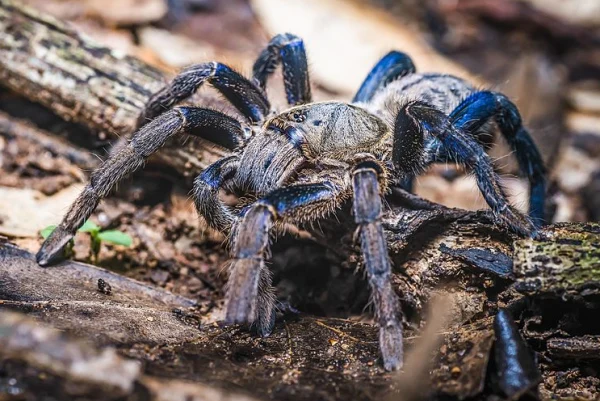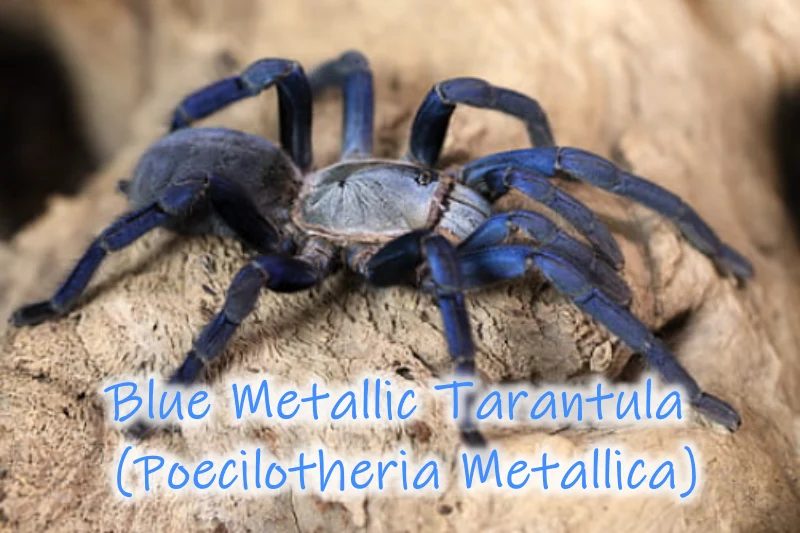The Blue Metallic Tarantula (Poecilotheria metallica), sometimes known as the peacock tarantula, is a member of the Theraphosidae family of tarantulas of the Old World. Within its genus, the Gooty sapphire tarantula is the only pure blue species.
Are you wondering what else there is to know about this outstanding species beyond its captivating appearance? Severely endangered, this particular tarantula species is pretty uncommon to keep as a pet. Read the article further to know more about the species.
Blue Metallic Tarantula (Poecilotheria Metallica): Wiki
| Scientific name | Poecilotheria Metallica |
| Common name | Gooty sapphire ornamental, Gooty sapphire, Gooty tarantula, blue metallic tarantula, peacock parachute spider, or peacock tarantula |
| Size | 2.5” (6cm) |
| Habitat | Deciduous forests |
| Location | Andhra Pradesh & Tamil Nadu, Central Southern India |
| Diet | Mostly invertebrates like caterpillars, small beetles, larvae, and cockroaches |
| Predators | larger spiders, arboreal snakes, birds, large mammals, hunting wasps, etc. |
| Colors | Sapphire blue, with adults showing more chromatic characteristics |
| Weight | 1-2 ounces |
| Life Span | Males: 3-4 years / Females: 11-12 years |
| Price | Can be very expensive, up to $500 |
| About it | Usually not harmful to humans as they have a timid nature |
Appearance of Poecilotheria Metallica
The Gooty Sapphire Tarantula displays a complex fractal-like pattern on its abdomen, just like other members of its genus, while being the only species with blue hair. They also have a similar geometric body coloring to other members of the genus.
However, they appear less chromatic when young; as they age, the color changes to blue. The mature males exhibit substantially less of this blue. Males also have longer legs and more slim bodies. That’s a distinctive feature between the two genders. Poecilotheria metallica has a leg span of 15-20 cm (6-8 in) at full growth.
Geo-Location
In Andhra Pradesh, in central southern India, the deciduous forest serves as the species’ natural habitat.
Only a restricted and small, nonetheless highly disturbed reserve forest less than 100 square kilometers (39 sq mi) in size is home to Poecilotheria metallica.
How Friendly the Poecilotheria Metallica Species Are?

Derived: Peter Coxhead (commons.wikimedia) (CC BY-SA 4.0)
Poecilotheria metallica’s behavior is similar to that of several arboreal spiders. They produce asymmetric funnel webs in the holes of large trees where they dwell in the wild. Several flying insects make up the main prey. However, when territory, or the number of holes per tree, is scarce, spiders of this genus may coexist in communities.
The species is timid and photosensitive. Thus, it will flee when light shines upon it. However, members of the species have been known to bite when provoked.
Is It a Good Buddy to Humans?
There has never been a record of fatality from its bite. However, based on the experiences of keepers bitten by other spiders in the species, Poecilotheria metallica’s bite is thought to be medically significant and may produce severe pain due to its venom.
The vast majority of bites are “dry bites,” where the victim is not injected with any venom. Given that an adult’s fangs can extend to almost 3/4 of an inch in length, the mechanical repercussions of the bite can still be concerning. When trapped, it can defend itself and move quickly.
The effects of venom can include an increase in heart rate, perspiration, headache, stinging, cramping, or swelling. And a week may pass before the effects wear off.
Some Facts To Ponder Upon
- Classified as Critically Endangered by the International Union for Conservation of Nature (IUCN), this species is vulnerable. This makes it illegal to export the species outside the nation and remove it from its endemic range. The main threat to them is habitat loss.
- This tarantula’s distinctive pattern and bright blue color make it extremely popular among hobbyists, which motivates many breeders to retain and produce more of this species.
- This is a fast-growing tarantula, with females growing to a maximum size of about 6″ and a lifespan of around 12 years, compared to the somewhat smaller males, who only survive around 4 years.
- Being an Old World tarantula, this species is quick and lacks urticating hair.
- When surprised or disturbed, this species of Poecilotheria does not seem very defensive, and they have a tendency to hide inside enclosures.
- This tarantula hates bright lights and is highly photosensitive.
Conclusion
The Gooty tarantula spider, Poecilotheria metallica is a beautiful species of an exotic genus. They are currently confined to a limited region, i.e., deciduous forest, and severely endangered. They are harmless to humans as they have a shy and conscious character. So now that we have all the necessary details and intriguing facts, we can wrap up this post here. Till we write another interesting article, don’t forget to read our other exciting ones.
Also Read:

Anjali Prasad, a B. Pharm. graduate who works as a content writer for HowItSee, is based in Delhi. Except for her, not many people take the typical road from healthcare to writing. Her love of writing stemmed from her involvement in the college literature society and her early journaling at the age of 7. Hence, the love of learning and the spirit of exploration are what drew her to this career. You can find her on common social media like Instagram.
